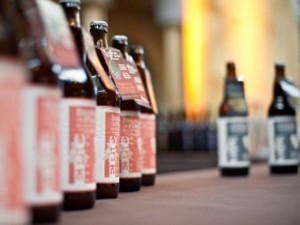
WASHINGTON – After a long day in the classroom, middle school teacher Melissa Repsch likes nothing more than to sit down to dinner with a beer – craft beer, that is.
Like a growing number of Americans, she has developed a passion for full-flavored beers from small-volume, fiercely independent local breweries that are redefining how the United States takes its favorite tipple.
“It’s something we enjoy,” said Repsch, 37, as she and husband Jake, 38, also a teacher, sampled some of the 149 different beers from 74 craft breweries at this year’s edition of Savor, the nation’s biggest beer-and-food event.
“The more (varieties of craft beer) we try, the more it seems we’re pushing for something unique and rare,” she added.
Beer is a $96 billion industry in the United States, dominated by three multinationals Belgium’s Anheuser-Busch InBev, best known for perennial best-seller Budweiser, Britain’s SABMiller and Canada’s Molson Coors.
But while overall beer sales dipped one percent in 2011, craft beer sales – which account for five percent of the entire market – surged 13 percent by volume and 15 percent by sales value.
What’s more, the total number of breweries in the United States now exceeds 2,000 – more than at any time since the 19th century, let alone the prohibition years of the 1930s.
“Americans have come of age now, wanting diversity and choice in the beers that they enjoy,” said Julia Herz, program director at the Brewers Association, the craft beer industry’s trade group.
“No longer does a light American lager satisfy every beer-lover’s occasion,” she told AFP in an interview.
With 4,000 attendees over two days, Savor – which takes place amid the soaring Corinthian columns and terra cotta friezes of the National Building Museum – is an event not to be missed for craft beer aficionados.
With tasting glasses in hand, chic professional women in smart cocktail dresses, and younger men who could have made more of a sartorial effort, put such brews as Curmudgeon Old Ale, Hardywood Mocha Belgique, Rosemary Swamp Fox, Skookumchuck Wild Ale, Idiot IPA and Hop’solutely to the taste test.
— Social networks help —
“I wouldn’t say people are giving up on Budweiser, but there is certainly a trend towards more full-flavored beers,” said Steve Kuftinec of Utah’s Uinta Brewing, makers of HOP Notch IPA, a “nicely balanced” India pale ale, and Labyrinth, a “ridiculously big barrel-aged Russian imperial stout.”
IPA, a hoppier version of conventional pale ale, first brewed in England in the 19th century for export to the Indian sub-continent, is far and away the most popular style of craft beer in the United States today.
From distant Hawaii, Garrett Marrero, founder with his wife Melanie of Maui Brewing, brought CoCoNut PorTer and Savrehumano Palena ‘ole as novel examples of their penchant for beer-making with quirky Hawaiian flavors.
“We look a lot to fruits and spices that we have locally,” such as coconut, guava, mango, papaya, passion fruit and pineapple, Marrero told AFP. “We’ve even used Maui onions.”
The Marreros used to work in finance before they put every penny they had into launching Maui Brewing seven years ago – at one point sleeping on the floor of their apartment because they couldn’t yet afford a mattress.
“It’s not something for the faint of heart,” Marrero told AFP. “It’s a lot of hard work… but we had passion and we knew what we wanted to do. We have a very clear vision.”
Social networks help spread the craft beer gospel. So do a raft of specialist publications and smartphone apps like Untappd, a kind of Twitter for hardcore-beer fiends.
“It’s fun stuff,” said consultant Rick Silver, who reckons he’s tried more than 6,000 individual types of beer – on top of the ones he brews at home – since he started keeping track in the mid-1980s.
From Durango, Colorado, co-owner David Thibodeau of Ska Brewing was still in a celebratory mood after its Steel Toe Stout took a gold medal at the World Beer Cup in San Diego last month.
Considering how sluggish the US economy has been, he said, “it’s pretty nutty” that the craft beer sector has thrived as it has.
“This term gets thrown around a lot,” he said, “but I would say it’s an affordable luxury. It’s something that people can treat themselves to without breaking the bank. I think that’s what got us through the downturn.”
Damian McConn, a Dublin native and master brewer at Summit Brewing Company of Saint Paul, Minnesota, found the American craft beer scene so promising that he immigrated 10 years ago to be part of it. He has no regrets.
“In terms of creativity, and innovation, I think the US is the place to be right now,” he said.
“In Germany or Belgium or Czech Republic, you’re seeing some of the most technically outstanding beers in the world – but we’re not seeing the range of beers that we are now seeing in the United States in the craft brewing sector.”









































